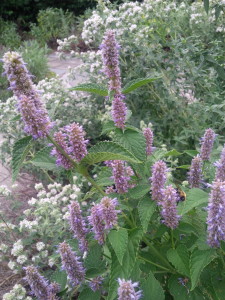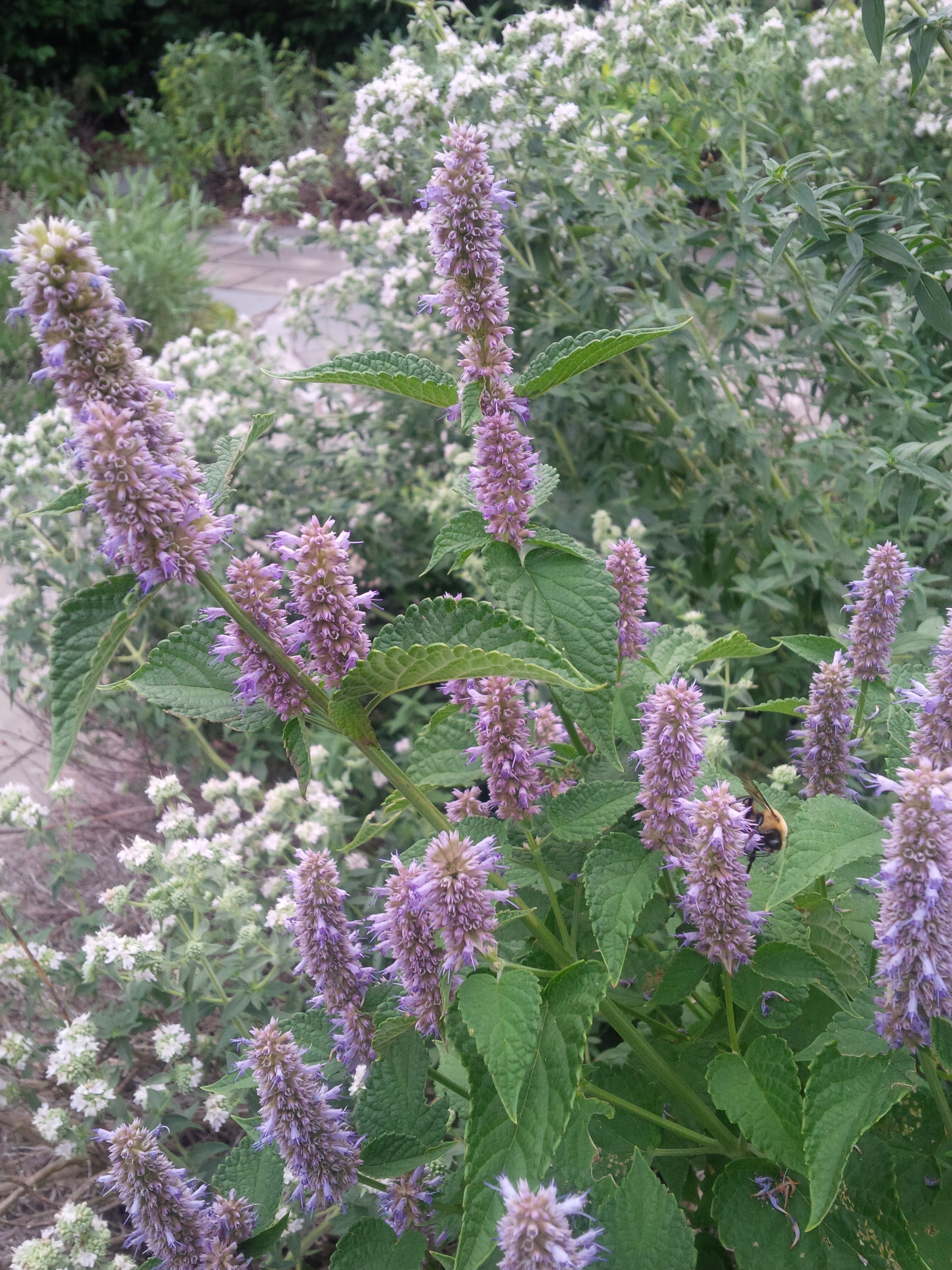 One of my favorite plants in the herb garden at Rutgers Gardens is anise hyssop (Agastache foeniculum). When the other herbs have finished their spring blooming season, the anise hyssop bursts into bloom for the summer.
One of my favorite plants in the herb garden at Rutgers Gardens is anise hyssop (Agastache foeniculum). When the other herbs have finished their spring blooming season, the anise hyssop bursts into bloom for the summer.
Anise hyssop is a member of the mint family. It is related to hyssop (Hyssopus officinalis) but is not the same plant. A native of North America, anise hyssop grows wild on prairies, dry forests, and plains. As its name implies, it has a light scent of anise or licorice. The Native Americans used it as a tea, for magic and as a protective charm.
It is a drought tolerant perennial that is hardy in zones 4 through 9. It prefers full sun but will tolerate some shade. Grow it in a xeriscape or in well-drained soil. The plants grow 2’ to 4’ tall with leaves that resemble catnip, also a member of the mint family. The flowers are tiny and lavender, and packed into spikes. The flowers are beloved by bees making this an excellent pollinator plant for your vegetable garden. Bees sipping the nectar of anise hyssop produce a very fragrant honey. The flowers are also attractive to butterflies making this a wonderful addition to your butterfly garden. Bloom time is June through September. You can deadhead the flowers to encourage more blossoms.
Growing anise hyssop from seed is very easy. You can direct sow your seeds in the garden in the fall where they will remain dormant until spring or you can start your seeds indoors at least a month before your last frost date. Press the seeds firmly into the soil and barely cover. They will germinate in about ten days. Keep your seedlings moist, but not soaking wet and set them out in your garden after your last frost.
You can also propagate anise hyssop by division taking advantage of the fact that it spreads by runners. Merely dig up the plants that are outside of or close to the clump. It’s best to choose young plants that have not had a chance to develop the long tap root that allows anise hyssop to survive in dry conditions.
Tea drinkers love anise hyssop for its leaves which they use both fresh and dry. Crafters love the flowers which retain their color after drying. To dry anise hyssop, flowers or leaves, cut the stems about 6 inches from the base of the plant and hang upside down in a cool, dark, well-ventilated area. After the plants have dried, store the dried leaves and flowers in tightly sealed glass jars.


10 Comments on “Anise Hyssop”
I have an anise hyssop plant out doors. Are the flowers that have dried able to be used? Or, would I have to dry them using the above method this season for most effective use?
Flowers that have dried on the plant will have less color and flavor than flowers that have been harvested from the plants and then dried indoors.
Do anise hyssop plants blossom in their first year if grown from seed? If you could please let me know that would be awesome:)
Yes, anise hyssop will bloom the first year when grown from seed.
We have had a lovely stand of Blue Fortune hyssop for years. The bees and yellow finch love them. This month, April in Missouri, we have noticed the hyssop is not sprouting. We did have an unusually long, cold spell this past winter. What do you think the problem is? Thank you for your time. Donna
Yes, it was probably the long spell of cold weather. Anise Hyssop is very hardy. Blue Fortune anise hyssop is a modern hybrid. Hybrids tend to be less hardy than their original parents. I would recommend replacing the Blue Fortune anise hyssop with original anise hyssop. You should be able to find it at herb sales.
thank you … that’s really helpful … have fingers and toes crossed they will bloom in the first year in cold northern England!
Please, please tell me the name of the lovely white flowers that are growing along side of the anise hyssop in your picture. I’ve just collected seed and can’t wait to grown them. Thank you!
They are called mountain mint and are a native plant. As their name implies, they are a member of the mint family. The plants smell minty and the flowers are a magnet for beneficial insects. WARNING! Mountain mint is extremely invasive so I don’t recommend that you plant it in a bed with other plants. Like all mints, it will crowd out the other plants and take over the bed. Plant it in its own bed away from valuable plants.
I grew up in Piscataway NJ and moved to Winthrop Maine in 2005. Anise hyssop is my all time favorite herb. It grows wonderful here in Maine . I use it in iced tea to make a wonderful flavor. I have a small orchard and lavender set farm here. I’m wondering if I can grow this for commercial use for anything.